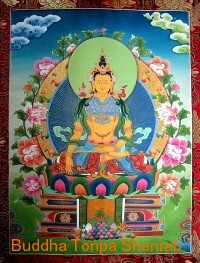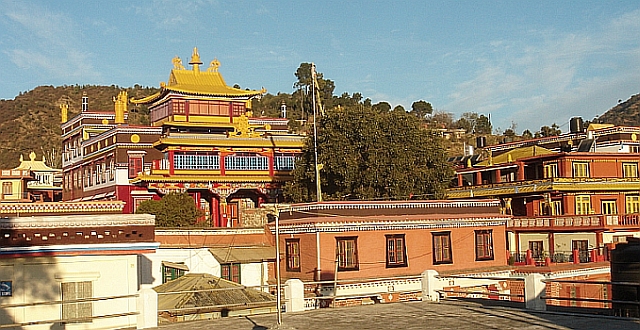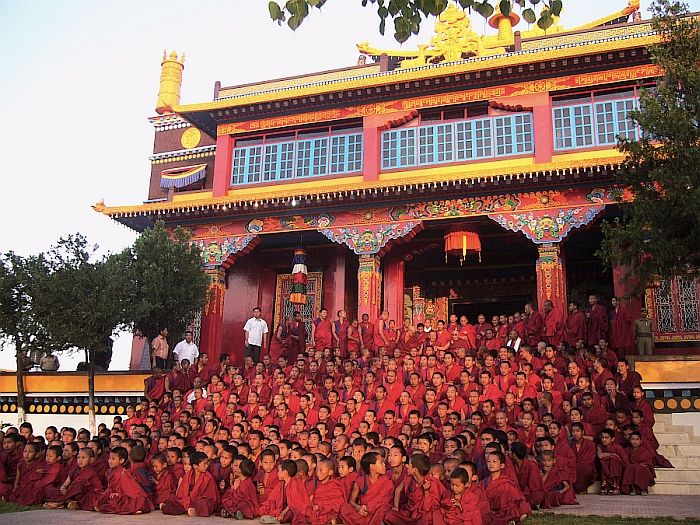
Bon and Bonpo
‘Bon’ means ‘Boundlessness’. Its essence is the truth that lies within everything. It is the truth that pervades throughout time and space. It is the miracle that manifests in every moment. Bon is also the spiritual tradition and ancient culture of the Zhang-Zhung Civilization and of Tibet.
The founder of the ancient Bon spiritual tradition was the Buddha Tonpa Shenrab. Tonpa Shenrab was born at the palace Barpo Sogye of Tagzig Olmo Lung Ring. According to the Bon canon, his birth dates 18,000 years ago. His father was Gyalbon Thodkar of the Mu clan and his mother Yonchi Gyalzhedma. His teachings are called ‘Yung Drung Bon’ or ‘Eternal Bon’, and practitioners of Bon are called ‘Bonpo’. The great Shenrab dedicated his whole life to the practice of Eternal Bon for the benefit of all beings. He taught the teaching of Eternal Bon for about five decades, showing the path of compassion to many beings. At the age of 82 he entered into nirvana. His death was a true remainder to many of his followers that we all have to experience the truth of impermanence. Throughout Shenrab’s teaching he tried to communicate with every being, showing them how to recognize their true nature and live with the moment. The essence of his teachings is how to find our home within and abide joyfully with the treasury of contentment that we are all gifted with. His teachings continue to inspire many beings throughout the centuries.
1,800 years later, Mucho Dem Drug organized and classified the entire teaching of Tonpa Shenrab into four categories. The prayers, mantras, the teachings on monastic discipline or precepts, and the biography of Tonpa Shenrab were arranged as part of the Sutra collection (mDo). The second category, Prajnaparamita or ‘Bum’, consists of the detailed exposition of the Perfection of Wisdom teachings. The third category, Tantra, consists of deity visualization, and ritual and esoteric tantric practices. The forth category, ‘mDzod’ consists of the teachings on Dzogchen meditation practices. He also wrote commentaries to these teachings and taught them to many students. Through his teachings and efforts, the teachings of Yung Drung Bon flourished throughout Zhang_Zhung and Tibet. Out of his many students, six become great scholars who translated the teachings of Yung Drung Bon into different languages: Mutsa Tahe and Guhuli Paraya translated Yung Drung Bon into the language of Tagzig. Tritok Partsa translated Yung Drung Bon into Zhang Zhung. Letang Mangpo translated Yung Drung Bon into Chinese. Lhadag Ngadro translated Yung Drung Bon into Indian language, and Sertok Chezam translated Yung Drung Bon into the language of Trom. Through the help of these great scholars, the teachings of Yung Drung Bon reached many parts of the world. In the Bon Canon, these six great scholars are known under the name of “Jamling Khepi Gyendrug”. Later, Tongyu Thuchen of Zhang Zhung translated Yung Drung Bon into Tibetan with the help of the three Tibetan scholars Shari Wuchen, GyimTsa Machung and Chetsa kharbu. After this, the teachings of Yung Drung Bon flourished throughout Tibet.
Around 1196 B.C., Zhutrul Yeshi, a great master from Tagzig established the Bon monastic system and propagated the practice of monastic discipline and philosophical study in the kingdoms of Zhang Zhung and Tibet with energy and devotion. Mutri Tsenpo, the second king of Tibet, was interested in the Bon trantric practice Drakpa Kor Sum and invited many scholars from Zhang Zhung to teach it. Through his efforts, the practice of Tantra, the path of transformation, flourished widely in Tibet.
In the late 7th century, Buddhism came to Tibet from India. During that transition period Bon faced difficulties, yet it survived with the help of great masters who buried and hid many Bon teaching resources. During the reign of Lang Darma, the 40th king of Tibet, Buddhism was entirely terminated. Its first transmission and Tibet went into a spiritual dark age for about a century and a half.
The second transmission for both Bon and Buddhist began around the 10th century. The great Bon master and Terton Shen Chen Luga (996-1035 AD) rediscovered many Bon scriptures that were hidden by earlier Bon masters. One of his students, Dru Yung Drung Lama, founded Yeru Wensaka Monastery in 1072 AD. Yeru Wensaka become the main study center of Bon Practice for many centuries. Unfortunately, it was destroyed by a flood. In 1405 AD, Nyamed Shenrab Gyaltsen from Yeru Wensaka Monastery founded Menri Monastery in place of Yeru Wensaka. Since then, Menri has become the mother monastery of all Bonpos. The abbot of Menri is given the title of the world spiritual head of the Bon tradition. Nyamed Shenrab Gyaltsen became the first abbot of Menri. During the Cultural Revolution in 1959, Menri was destroyed. Later it was reestablished in northern India by Yongzding Tenzing Namdak Rinpoche and His Holiness Lungtok Tenpei Nyima Rinpoche, the 33rd Menri Trizin and head of the Bon tradition.
By Tempa Dukte Lama

Menri Monastery Dholanji India


